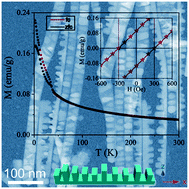Solution synthesis of conveyor-like MnSe nanostructured architectures with an unusual core/shell magnetic structure†
Abstract
We report for the first time one-dimensional (1D) wurtzite (WZ) MnSe nanoconveyors with a single-crystalline configuration fabricated by a solution-processed colloidal method. High-resolution transmission electron microscopy (HRTEM) measurements show that the stem of MnSe nanoconveyors grows along the [1![[1 with combining macron]](https://www.rsc.org/images/entities/char_0031_0304.gif) 00] direction, while the teeth grow along the [0001] direction. We find that the initial WZ nanobelts with the [1
00] direction, while the teeth grow along the [0001] direction. We find that the initial WZ nanobelts with the [1![[1 with combining macron]](https://www.rsc.org/images/entities/char_0031_0304.gif) 00] growth direction are crucial to the formation of nanoconveyors, whereas the teeth are a result of a self-catalyzed growth process induced by the Mn-terminated (0001) surface. The magnetic measurements suggest that 1D WZ MnSe nanoconveyors consist of an antiferromagnetic core and a ferromagnetic shell below the blocking temperature. Furthermore, the hysteresis measurements indicate that these nanoconveyors have 300 Oe coercive fields, which is attributed to the high surface-to-volume ratio of the nanoconveyors. This facile solution-based strategy can be anticipated to synthesize WZ metal chalcogenide nanomaterials with 1D hierarchical structures, for potential applications from spintronics to photocatalysis.
00] growth direction are crucial to the formation of nanoconveyors, whereas the teeth are a result of a self-catalyzed growth process induced by the Mn-terminated (0001) surface. The magnetic measurements suggest that 1D WZ MnSe nanoconveyors consist of an antiferromagnetic core and a ferromagnetic shell below the blocking temperature. Furthermore, the hysteresis measurements indicate that these nanoconveyors have 300 Oe coercive fields, which is attributed to the high surface-to-volume ratio of the nanoconveyors. This facile solution-based strategy can be anticipated to synthesize WZ metal chalcogenide nanomaterials with 1D hierarchical structures, for potential applications from spintronics to photocatalysis.



 Please wait while we load your content...
Please wait while we load your content...